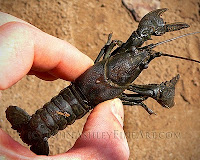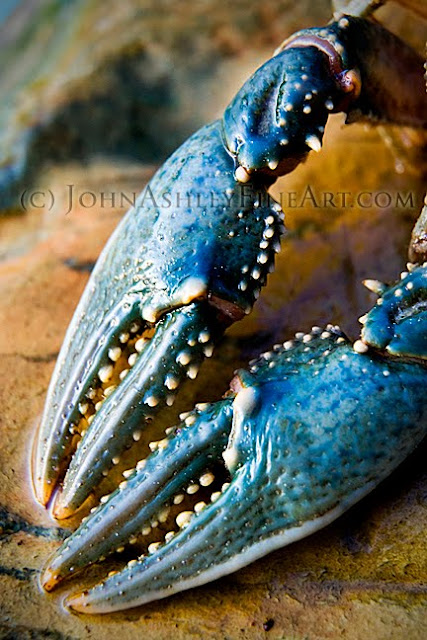In this part of the world, the "Brawl of the Wild" is our annual cross-state football confrontation between the Montana State Bobcats and the University of Montana Grizzlies. But another brawl may be brewing.
Two of our native crayfish species appear to be on a collision course. From the eastern plains, the Virile Crayfish (Orconectes virilis) is expanding its range into the western mountains. And from the west, the Signal Crayfish (Pacifastacus leniusculus) is marching eastward towards the plains. These invading crustaceans are lumbering towards each other at the glacial speed of roughly one-half mile per year.
It's a long, slow march.
A third native species, the Calico crayfish (O. immunis), is more of a homebody. This non-migratory crayfish lives in the slow waters of Montana's eastern plains. It has a very small home range, and it's becoming rare due to the invasion of the larger Virile crayfish. There are also historical reports of one other species, the Pilose crayfish (P. gambelii), in the upper Missouri River drainages, but none have been found in state waters or museum collections. If it ever lived in Montana, it's missing now.
Like some football players, crayfish are generally solitary, cantankerous and omnivorous. But they might also surprise you with occasional displays of intelligence.
Crayfish are aggressive and territorial. By day, they hang out in muddy burrows or hidden under rocks or debris in lakes and rivers. By night, they come out to eat and to fight. When rivals meet, they size each other up in a ritualized display based on the size of their front claws, or "chelae," and decide whether to fight or flee.
Among females, the victorious crayfish always has larger and stronger claws than the defeated foe. But some males bluff their opponents by growing larger claws that are actually weaker in pinching power. (Nothing is too obscure for some biologist, somewhere, to measure.) Growing larger but weaker claws is described in the biological literature as, "Dishonesty in weapons signaling."
In other words, females tend to be true and males tend to lie. No behavioral news there.
 All crayfish, males and females, are omnivorous. They'll eat just about anything they can catch with their claws and shred with their mouths. Vegetation, snails, insect larvae, tadpoles. Even some small fish, turtles and garter snakes. All of that shredding creates organic debris for smaller animals to eat. Craryfish also make tasty snacks for pelicans, cormorants and loons. But for the most part, invasive crayfish out-compete and displace native animals wherever they show up.
All crayfish, males and females, are omnivorous. They'll eat just about anything they can catch with their claws and shred with their mouths. Vegetation, snails, insect larvae, tadpoles. Even some small fish, turtles and garter snakes. All of that shredding creates organic debris for smaller animals to eat. Craryfish also make tasty snacks for pelicans, cormorants and loons. But for the most part, invasive crayfish out-compete and displace native animals wherever they show up. With this combination of crayfish behavior and appetite, the intentional drafting of non-natives can lead to a string of defeats.
Unlike Montana, Arizona has no native crayfish. So for decades, fishermen and government agencies released exotic crayfish to eat aquatic weeds and feed bass. Now, some once-clear Arizona streams have been churned into muddy messes by the non-native crustaceans. First, the aquatic vegetation was devoured, then the native snails and smallest animals dissappeared. And now there are documented declines in Arizona's turtles, frogs and fish in the infested waterways. For these reasons, in Montana it is now illegal to import or move crayfish from one waterway to another.
 Despite their rough-and-tumble personality, crayfish might surprise you with their intellectual prowess.
Despite their rough-and-tumble personality, crayfish might surprise you with their intellectual prowess. Australian researchers have shown that crayfish can recognize and remember the faces of other individual crayfish, especially if they've fought before. Only a handful of invertebrates share this ability. Crayfish also remember the smell of their foes. Other research has shown that crayfish can make complex cost-benefit calculations when simultaneously confronted with the scent of food and the sight of a predator.
On the other side of the ball, crayfish were one of the animal families that guided early scientists towards the theory of Pangaea -- that the Earth's surface previously consisted of one humongous continent surrounded by ocean. The scientists were puzzled how crayfish, which can't tolerate salt water, appeared on nearly every continent. As the super continent, Pangaea, broke up into smaller continents, the crayfish ancestors drifted apart in space and speciation. Fossil crayfish burrows have been discovered in southern Australia from 115 million years ago, when it was still attached to Antartica.
In modern times, there are more than 400 crayfish species in North America alone. They can survive just about anywhere that has permanent water - lakes, ponds, rivers and marshes. Being cold-blooded, they eat and grow more during summer when the water temperature is above 50 F degrees. Their skeleton is an external shell, not internal bones. So as they eat they must periodically shed their exoskeleton in order to grow larger. A new exoskeleton is soft, so a molting crayfish hides for a few days until his new helmet hardens.
In Montana, native crayfish grow to about 3" to 4" long and live to the ripe old age of 2 to 3 years. The life cycle begins anew each summer, when females carry their eggs on their belly for 4 to 6 weeks. As the waters start warming, the young start hatching. The miniature crayfish stay attached to mom until they have grown and shed a few exoskeletons and are large enough to venture out on their own. Juveniles may molt more than 10 times in their first year. As their growth rate slows, they may only molt once each year by the time they are adults.
As new generations of Montana crayfish grow up and disperse, our two migratory species will colonize new waterways along the edges of their range. Without knowing it, these distant relatives may be rumbling towards a future cross-state "brawl of the wild."
Just don't expect this one to be televised.
Collecting crayfish records: The university of Washington is trying to collected crayfish records and observations in the Pacific Northwest into one central database. You can report your observations here.
Behind the lens: The top photo was a very cooperative crayfish, as he was just recently deceased. I turned him around and set him on top of the rock where I found him, so he would be reflected in the lake surface. A live crayfish would prefer to be under the rock instead.



